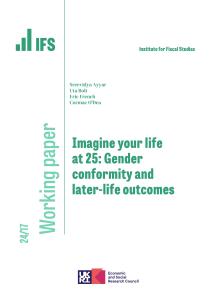In the March 2023 Budget, the government announced the largest and fastest expansion of free childcare on record, doubling spending on the free entitlement to a funded childcare place in just three years. By September 2025, the programme will offer up to 30 hours a week of funded term-time care to all children in working families from the age of nine months until the start of school. Currently, 30-hour funded places are only available to 3- and 4-year-olds in working families.
The new entitlements continue the trend towards prioritising childcare support towards parents who work, rather than universal services or targeted early education for low-income families. Indeed, the poorest third of families will see almost no direct benefit from the new entitlements. Meanwhile, the share of disadvantaged 2-year-olds eligible for a funded childcare place has fallen from nearly 40% in 2015 to just over a quarter in 2022–23.
The scale and distribution of the new entitlements are among the findings of IFS research analysing spending on the early years and childcare over time, funded by the Nuffield Foundation as part of the IFS’ annual series of updates on education spending.
The report also highlights the importance of getting the funding rates right for these major new entitlements. At the start of this month, the government increased funding rates for existing childcare places; hourly rates are set to rise again in 2024. The research finds that:
- Younger children have been prioritised for bigger funding increases: 2-year-olds have seen their funding rate rise by a third, from an average of £6.00 an hour to £7.95. Even after providers’ rising costs are taken into account, this will leave resources around £1 an hour higher in real terms than their previous peak – and well above current market prices for childcare.
- Meanwhile, funding for 3- and 4-year-olds has risen this month by a lower (but still significant) 6%. But these rate rises come on the back of a 17% fall in core funding in the decade leading up to 2022–23. Even with the rate increases, per-hour resources for 3- and 4-year-olds will still be 11% lower on this measure in 2024–25 than in 2012–13.
- Getting these funding rates – and the process for setting them – right is crucial to ensure plans are deliverable and maintain the quality of childcare. Once the new entitlements are fully rolled out, the government could be paying for 80% of formal pre-school childcare in England.
Elaine Drayton, IFS Research Economist and an author of the report, said:
‘Childcare providers have seen significant increases in their costs over the last decade, but funding rates have failed to keep pace. Core hourly funding for 3- and 4-year-olds fell by 17% in the decade leading up to 2022–23, once rising costs of provision are taken into account. As the free entitlement expands, the government will be setting the price for more and more of formal pre-school childcare hours – and the risks to getting the funding rates wrong will get bigger and bigger.’
Christine Farquharson, IFS Associate Director and an author of the report, said:
‘Spending on the free entitlement is now four times higher than it was two decades ago. With the new childcare entitlements announced in the Budget, it’s now set to double again over just three years. But these new entitlements are another big step towards an early years system focused on helping parents to work – with much less to say about reducing inequalities in children’s development.’
Josh Hillman, Director of Education at the Nuffield Foundation, commented:
‘This report demonstrates the huge scale of government funding required to deliver the new childcare entitlements. While the new money announced in the Budget is welcome, it is disappointing to see the analysis confirm a significant drop in the number of disadvantaged 2-year-olds that will be eligible for free childcare.’









